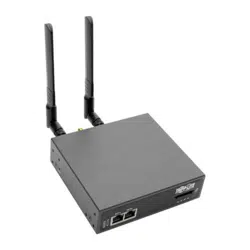Loading ...
Loading ...
Loading ...

212
14. Configuration from the Command Line
For those who prefer to configure their console server at the Linux command line level (rather than use a browser and the
management console), this chapter describes using command line access and the config tool to manage the console server
and configure the ports.
When displaying a command, this chapter uses single quotes (‘’) for user defined values (e.g., descriptions and names).
Element values without single quotes must be typed exactly as shown.
14.1 Accessing Config from the Command Line
The console server runs a standard Linux kernel and embeds a suite of open source applications. If you do not want to use a
browser and the management console tools, you can configure the console server and manage connected devices from the
command line using standard Linux and Busybox commands as well as applications like ifconfig, gettyd, stty, powerman,
NUT, etc. However, without careful management, these settings may not withstand a power-cycle-reset or reconfiguration.
Tripp Lite provides a number of custom command line utilities and scripts that easily configure the console server and ensure
changes are stored in the console server’s flash memory.
The config utility allows manipulation of the system configuration from the command line. With config, a new configuration can
be activated by running the relevant configurator, which performs the action necessary to make the configuration changes live.
To access config from the command line:
• Power up the console server and connect the “terminal” device:
o If connecting using the serial line, plug a serial cable between the console server’s local DB-9 console port and the
terminal device. Configure the serial connection of the terminal device you are using to 115200bps, 8 data bits, no parity
and one stop bit.
o If you are connecting over LAN, you will need to interconnect the Ethernet ports and direct your terminal emulator program
to the IP address of the console server (192.168.0.1 by default).
• Log on to the console server by pressing return a few times. The console server will request a username and password. Enter
the username root and the password default. The command line prompt should appear as a hash (#).
This section is not intended to teach you Linux. In following these instructions, we assume you already
have a certain level of understanding before executing Linux kernel level commands.
The config tool
Syntax
config [ -ahv ] [ -d id ] [ -g id ] [ -p path ] [ -r configurator ] [ -s id=value ] [ -P id ]
Description
The config tool is designed to perform multiple actions from one command so options can be chained together.
The config tool allows manipulation and querying of the system configuration from the command line. Using config, the
new configuration can be activated by running the relevant configurator, which performs the necessary action to apply the
configuration changes in real-time.
The custom user configuration is saved in the /etc/config/config.xml file. This file is transparently accessed and edited when
configuring the device using the management console browser GUI. Only the user ‘root’ can configure from the shell.
By default, the config elements are separated by a ‘.’ character. The root of the config tree is <config>. To address a specific
element, place a ‘.’ between each node/branch. To access and display the description of user1, type:
# config -g config.users.user1.description
The root node of the config tree is <config>. To display the entire config tree, type:
# config -g config
To display the help text for the config command, type:
# config -h
Loading ...
Loading ...
Loading ...
